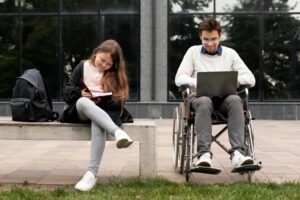Learning through different channels
Materials
1. Introduction
Learning is a multifaceted process that holds significant importance in both the business realm and personal career growth. It spans various dimensions, from individualized journeys to collaborative endeavors within Higher Education Institutions (HEIs) and professional networks.
Collaboration within HEIs stands as a cornerstone for fostering professional development, knowledge dissemination, and innovation. It serves as a conduit for tapping into collective wisdom, encouraging interdisciplinary perspectives, and facilitating the exchange of practical strategies among educators. Formal learning within these collaborations often involves structured and intentional educational experiences, providing a framework for guided skill development and in-depth exploration of specific subjects.
Conversely, informal learning takes place spontaneously outside formal educational settings, driven by curiosity, interaction, and hands-on experiences. This informal learning landscape thrives on serendipitous encounters, peer-to-peer interactions, and self-directed exploration, complementing the structured approach of formal education.
The mode of collaboration can vary, ranging from online platforms to offline face-to-face interactions. Online collaboration offers unparalleled accessibility, efficiency, and global reach, breaking down geographical barriers and enabling seamless knowledge exchange across borders. On the other hand, offline collaboration fosters human connection, facilitates immediate feedback, and nurtures networking opportunities, essential elements for building strong professional relationships and trust.
Each mode of collaboration comes with its own set of advantages and challenges. Online collaboration demands digital literacy, effective communication skills, and the ability to navigate virtual spaces efficiently. Offline collaboration, while fostering interpersonal connections, requires physical presence and logistical coordination.
A hybrid approach that combines the strengths of both online and offline collaboration holds immense potential for driving innovation and facilitating knowledge exchange. By leveraging digital platforms for asynchronous communication and offline interactions for synchronous engagement, this blended approach offers the best of both worlds, catering to diverse learning preferences and overcoming the limitations of each mode.
Moreover, learning through professional networks amplifies the collaborative character by providing a dedicated platform for educators to share resources, exchange insights, and support one another in their pedagogical endeavors. These networks serve as incubators for best practices, innovative teaching methods, and continuous professional growth, enriching the educational landscape and empowering educators to thrive in an ever-evolving learning ecosystem.
2. Learning through collaboration within the HEI
Within the HEI, a wealth of knowledge and expertise exists among fellow educators. Collaborating with fellow teachers within HEI provides a rich opportunity for professional development, knowledge exchange, and innovation. Whether through formal workshops, informal discussions, or joint projects, collaborating with institutional colleagues can lead to transformative insights.
Therefore, collaboration within HEI brings numerous benefits. Firstly, it allows for the harnessing of the collective wisdom present within the institution. By pooling together the diverse expertise and experiences of colleagues across various disciplines, collaborative efforts enable us to draw upon a rich source of insights and knowledge. Secondly, collaborating with colleagues from different departments promotes cross-disciplinary insights. These interactions encourage the exchange of ideas, sparking creativity, challenging existing assumptions, and ultimately fostering innovative teaching practices. Lastly, collaboration facilitates the sharing of practical strategies among educators. Through both face-to-face interactions and online platforms, teachers can exchange valuable techniques for refining assessment methods, designing engaging activities, and addressing student needs. Ultimately, this collaborative approach enhances HEIs collective pedagogical toolbox, benefiting both educators and learners alike. (Rio, 2022)
a) Formal vs informal learning through collaboration
Based on the characteristics of learning through collaboration, the two primary categories can be defined (Kolleck et al., 2021; Rio, 2022):
- Formal learning and
- Informal learning
Formal learning within HEIs encompasses structured, planned, and intentional educational experiences. These experiences are integral parts of formal curricula, courses, and programs. They take place within a structured environment such as classrooms, lecture halls, or online platforms. Clear learning objectives are defined, and assessments are used to measure student progress. Faculty members or instructors typically lead the learning process, and successful completion often leads to certificates, degrees, or qualifications. Examples of formal learning include lectures, seminars, workshops, and degree programs.
Conversely, informal learning occurs spontaneously outside formal educational settings. It is often self-directed and driven by personal interests. Informal learning happens in various contexts such as conversations, social interactions, or experiential activities. There’s no prescribed curriculum or syllabus, and learners take the initiative to explore topics of interest. Informal learning doesn’t involve formal assessments or grades. Examples include collaborative discussions, peer mentoring, reading articles, attending conferences, and participating in online forums.
Table 1. Difference between characteristics of formal and informal learning
| Formal learning | Informal learning | |
| Characteristics | Structured Environment | Flexible and Unstructured |
| Explicit Learning Objectives | No Prescribed Curriculum | |
| Instructor-Led | Self-Motivated | |
| Certification | No Formal Assessment | |
| Examples | Lectures, seminars, workshops, and degree programs fall under formal learning. | Collaborative discussions, peer mentoring, reading articles, attending conferences, and participating in online forums are examples of informal learning. |
In general, both formal and informal learning offer distinct benefits. Formal learning provides a systematic foundation of knowledge and skills, offers recognized credentials, and facilitates a deep understanding of specific subjects. On the other hand, informal learning encourages lifelong learning, fosters creativity and curiosity, and allows for personalized exploration, contributing to a well-rounded educational experience.
Although formal workshops and structured sessions treat a more formal approach, there are distinct advantages to engaging in this more structured collaborative. For example (Billett, 2012; Diploma Safe, 2023; Xu et al., 2023):
- In-depth exploration of topics: Formal collaboration allows for a deeper dive into specific subjects. Workshops, seminars, and formal research groups provide a structured environment where participants can explore complex topics thoroughly (Xu et al., 2023).
- Guided learning and skill development: In formal settings, experts or facilitators guide the collaboration. This guidance ensures that participants acquire specific skills, knowledge, and competencies related to their field of study or research (Billett, 2012).
- Structured problem-solving: Formal collaboration often involves problem-solving sessions, case studies, or research projects. Participants follow a systematic approach, analyze data, and propose evidence-based solutions (Xu et al., 2023).
- Certification and recognition: Successful completion of formal collaborative programs often leads to certificates, qualifications, or credentials. These serve as tangible evidence of professional development and expertise.
- Research consortia and grants: Formal research collaborations enable institutions to form consortia. These consortia pool resources, share expertise, and apply for research grants. Collaborative research projects benefit from funding and collective brainpower.
- Standardized assessment and evaluation: Formal collaborations adhere to established assessment criteria. Researchers, educators, or practitioners can evaluate outcomes objectively, ensuring quality and consistency.
- Structured networking opportunities: Formal conferences, symposia, and academic events provide networking platforms. Participants can connect with peers, industry experts, and potential collaborators.
- Focused research and innovation: Formal research collaborations concentrate efforts on specific research areas, fostering innovation and advancing knowledge.
While formal workshops and structured sessions have their place, the magic of informal discussions lies in their spontaneity and authenticity, and informal collaboration also offers several valuable benefits. For example (Arndt, 2023; Conti, 2022; Decius et al., 2019; Dive, 2023; Kittel & Seufert, 2023; Löhr et al., 2020; Seelig, 2013):
1. Cross-pollination of ideas: In casual conversations, teachers share their experiences, insights, and creative approaches. These exchanges often lead to fresh perspectives and innovative teaching methods. A passing comment from one colleague can spark inspiration in another.
2. Practical tips and tricks: Informal discussions provide a platform for practical and helpful advice. Teachers share classroom management techniques, time-saving strategies, and troubleshooting tips. Whether it’s handling challenging students or navigating technology glitches, these real-world solutions enhance our teaching toolkit.
3. Building relationships: Beyond professional collaboration, informal discussions foster personal connections. Knowing your colleagues as individuals—learning about their teaching philosophies, hobbies, and life stories—creates a supportive network. These relationships contribute to a positive work environment.
4. Validation and encouragement: Teaching can be isolating at times. Informal chats remind us that we’re not alone in our struggles. When a colleague shares a similar challenge or celebrates a small victory, it validates our experiences and encourages perseverance.
5. Serendipitous discoveries: Sometimes, the most valuable insights emerge unexpectedly. A hallway chat about a recent conference, a book recommendation, or a teaching mishap can lead to transformative changes in our practice. Informal discussions are fertile ground for serendipity.
In summary, while informal discussions have their unique charm, formal collaboration provides structure, depth, and recognition within HEIs. Both approaches complement each other, enriching the overall learning and research landscape.
b) Online collaboration vs offline collaboration
Based on the method of cooperation or collaboration channels, collaboration can be categorized into two main types: online collaboration, which occurs through digital platforms and tools, and offline collaboration, which takes place through face-to-face interactions or traditional communication methods.
Online collaboration refers to interactions, communication, and joint work conducted through digital platforms and tools, transcending geographical boundaries and enabling educators and researchers to collaborate remotely. This form of collaboration offers several advantages. Firstly, it provides accessibility, allowing participants to engage from anywhere with an internet connection. Additionally, it enhances efficiency by reducing travel time and facilitating instant communication. Digital platforms also promote efficient information sharing, document collaboration, and real-time updates. Moreover, online collaboration offers flexibility, as participants can collaborate asynchronously, accommodating different schedules. Lastly, it fosters a global reach by connecting individuals worldwide, thus fostering diverse perspectives. However, online collaboration also presents challenges, such as the lack of physical presence hindering relationship-building, technical issues like connectivity problems and software glitches, potential feelings of isolation, and the importance of addressing security concerns to protect sensitive data and privacy.
Offline collaboration involves in-person interactions, workshops, seminars, and joint activities within physical spaces. This mode of collaboration offers unique advantages, such as building human connection through face-to-face interactions, which fosters trust, rapport, and a sense of community. Real-time discussions enable immediate feedback and brainstorming, while nonverbal communication cues such as body language enhance understanding. Offline collaboration also provides networking opportunities through conferences and workshops, as well as the benefit of collaborators working in the same physical context. However, offline collaboration comes with its own set of challenges, including logistical issues like scheduling meetings and travel arrangements, geographical constraints limiting participation to those in close proximity, time-consuming coordination efforts, and associated costs such as travel, accommodation, and event organization.
Table 2. Difference between characteristics of online and offline collaboration
| Online collaboration | Offline collaboration | |
| Advantages | Accessibility | Human Connection |
| Efficiency | Immediate Feedback | |
| Information Sharing | Nonverbal Communication | |
| Flexibility | Networking | |
| Global Reach | Shared Environment | |
| Challenges | Lack of Physical Presence | Logistics |
| Technical Issues | Geographical Constraints | |
| Isolation | Time-Consuming | |
| Security Concerns | Costs | |
| Example | Virtual meetings, shared documents, online forums, and collaborative project management tools. | Departmental meetings, interdisciplinary workshops, research seminars, and campus-based collaborations. |
In summary, both online and offline collaboration play vital roles within HEIs, each offering distinct advantages and catering to different needs and contexts. Effective collaboration within higher education often involves leveraging a combination of online and offline strategies to maximize engagement, productivity, and innovation among participants.
Therefore, many HEIs adopt hybrid models, combining online and offline elements to leverage the strengths of both approaches. These hybrid approaches include blended learning, which integrates online and face-to-face components in courses, virtual conferences featuring online sessions and networking events, and collaborative spaces designed for both digital and in-person collaboration. By strategically blending online and offline collaboration, HEIs can create a holistic collaborative ecosystem that fosters innovation, knowledge exchange, and professional growth.
3. Learning through professional networks from other teachers
Learning from other educators through online networks or communities of practice, such as eTwinning, provides an invaluable platform for teachers to share resources, teaching strategies, and support. These collaborative environments empower educators to connect with peers from diverse educational backgrounds and regions, fostering a global perspective in teaching practices. Additionally, they facilitate the exchange of best practices and innovative teaching methods that can be adapted to suit different learning environments and student needs. Collaborating on projects within these communities enhances student learning experiences, resulting in more engaging and effective education. Moreover, educators can develop professionally through webinars, courses, and peer feedback, ensuring they remain at the forefront of educational innovation. (European School Education Platform, 2024; Thakuria, 2024; WGU, 2021)
Furthermore, these communities offer a space for educators to reflect on their teaching practices by engaging in meaningful discussions, leading to improved teaching methodologies. They also provide access to a wealth of resources, including lesson plans, multimedia materials, and research papers, which enrich the curriculum. Participating in cross-cultural exchanges not only broadens educators’ horizons but also prepares students for a more interconnected world. Additionally, educators receive recognition for their contributions and achievements, which can be motivating and affirming. (European School Education Platform, 2024; Thakuria, 2024; WGU, 2021)
By leveraging these platforms, educators can create a dynamic and supportive ecosystem conducive to lifelong learning and continuous professional growth. Such communities play a pivotal role in driving innovation and excellence in the education sector, ultimately leading to better educational outcomes for students worldwide.
The most known community in the EU is eTwinning. It presents a dynamic movement that empowers educators across Europe to innovate and collaborate. As a cornerstone of the European Union’s eLearning program, eTwinning offers a rich tapestry of cultural and educational exchange that transcends geographical boundaries. In general, the official website provides comprehensive resources and insights into the transformative role in education. An in-depth examination of the multifaceted eTwinning platform highlights its complexity and the numerous benefits it offers, including (European School Education Platform, 2024):
- Inclusive community: eTwinning provides an inclusive platform where educators from various types of schools and educational levels can come together to form a cohesive and supportive network.
- Project-based learning: The platform encourages project-based learning, enabling teachers and students to collaborate on joint projects, thereby fostering critical thinking, creativity, and problem-solving skills among students.
- Safe digital environment: With a commitment to online safety, eTwinning ensures a secure digital space for educators to interact and collaborate, safeguarding personal data and intellectual property.
- Diverse networking opportunities: eTwinning’s extensive network encompasses not only teachers but also education professionals, policymakers, and researchers, enriching the dialogue and exchange of ideas.
- Continual professional growth: The platform is dedicated to the continual professional growth of educators, offering a plethora of resources for self-improvement and career advancement.
- Recognition of Excellence: Through its Quality Labels and European Prizes, eTwinning acknowledges and celebrates its members’ hard work and innovation, providing a benchmark for excellence in education.
- Ambassador program: The Ambassador Program exemplifies eTwinning’s commitment to community building, with experienced members mentoring new entrants and promoting best practices.
The eTwinning network is a collective of numerous educators and teachers who are united by the goal of fostering inclusive educational environments. They effectively integrate information and communication technology to harness the full potential of skills relevant to the 21st century. eTwinners engage in networking both virtually and in person, including at schools, various eTwinning gatherings, and conferences, always seeking opportunities to motivate their peers towards enhancing student education. Within the European School Education Platform, the eTwinning section provides a wealth of resources such as project templates, case studies, personal accounts, and a collaborative online space. Here, members can exchange ideas, embark on joint projects, and pursue learning in a manner that aligns with their individual interests and at a comfortable pace. (European School Education Platform, 2024)
The eTwinning platform provides its members a suite of collaborative and networking opportunities. eTwinners have the ability to connect, exchange ideas, and work together with fellow registered members and educational institutions. This is facilitated through the platform’s social networking capabilities, participation in (European School Education Platform, 2024):
- specialized groups called Rooms: These are intimate clusters designed for eTwinners to engage in video conferences, complemented by a supportive forum and a repository for files.
- involvement in eTwinning groups: These are online spaces where eTwinners gather to deliberate on particular subjects or interests. Featured Groups are specially curated by the Central Support Service (CSS) and are guided by seasoned eTwinners.
- contribution to European projects: These are initiatives that encompass various subjects and essential competencies, requiring the collaboration of at least two teachers and their students. Each project is granted its own TwinSpace—a secure, exclusive platform accessible only to project members, invited guests, and selected students.
Additionally, eTwinners are invited to partake in online professional growth programs organized by the European School Education Platform, some of which are custom-made for eTwinners (European School Education Platform, 2024):
- Short online courses: These are compact, engaging courses that introduce educators to new topics, spark creativity, and foster skill enhancement.
- MOOCs: Spanning 4-6 weeks and demanding 12 – 25 hours of commitment, these Massive Open Online Courses allow participants to engage in learning activities at their leisure and earn a certificate upon completion.
- Webinars: These are live, one-hour video sessions offering educators the opportunity to explore and converse about diverse educational topics.
- Webinar series: A set of two webinars linked by an interactive online task.
- Online conferences and events: Tailored gatherings focusing on specific groups and educational themes.
The eTwinning is accessed here.
Although eTwinning is the most known community, there are also other online communities for educators that offer similar opportunities for collaboration, professional development, and resource sharing as eTwinning. For example:
- LinkedIn Groups: Relevant LinkedIn groups can be used to connect with educators in the same field.
- X (Twitter) Chats: Educational Twitter chats can be used to exchange ideas, ask questions, and learn from peers.
- Facebook Pages: Facebook pages dedicated to educational topics or subject areas can be used for education.
- Blogs: Educational blogs where teachers share experiences, teaching strategies, and reflections.
4. Conclusion
Learning is an indispensable process in both the business environment and personal career development. It is a multifaceted journey that can be highly structured, with predefined steps and established methodologies, or it can be a fluid, individualized process that adapts to the unique needs and contributions of those involved.
Both within HEIs and through professional networks from other teachers, collaboration emerges as a powerful catalyst for professional growth, knowledge sharing, and innovation. It harnesses the collective wisdom of educators, drawing from a wellspring of diverse experiences and expertise. This collaborative spirit not only fosters cross-disciplinary insights that challenge conventional boundaries but also encourages the sharing of practical strategies that enhance teaching effectiveness.
The advent of digital technology has expanded the horizons of collaboration, enabling online interactions that transcend geographical limitations. Online collaboration offers unparalleled accessibility, allowing educators to connect and contribute regardless of their physical location. It enhances efficiency, reduces the need for travel, and provides a flexible framework for asynchronous engagement. Moreover, it extends a global reach, inviting a rich tapestry of perspectives from around the world.
Concurrently, offline collaboration remains a vital component of the learning ecosystem within HEIs. It nurtures human connections through face-to-face interactions, fostering trust and rapport. Immediate feedback and the richness of nonverbal communication in offline settings create a dynamic environment for brainstorming and problem-solving. Additionally, it presents valuable networking opportunities that can lead to lasting professional relationships and collaborations.
A hybrid approach that leverages the strengths of both online and offline collaboration can provide a comprehensive framework for learning and innovation. It allows for a seamless integration of digital efficiency with the authenticity of personal interaction. Through professional networks, educators can share resources, teaching strategies, and support, fostering a community of practice that thrives on the exchange of best practices and innovative teaching methods. This holistic approach to collaboration within HEIs and through professional networks not only enriches the professional development of educators but also elevates the overall quality of education, preparing students to navigate an increasingly complex and interconnected world.
Therefore, a successful learning process frequently entails capitalizing on collaborative efforts within higher education institutions and drawing upon the collective expertise of professional networks among educators to optimize knowledge dissemination.
References
Arndt, H. L. (2023). Construction and validation of a questionnaire to study engagement in informal second language learning. Studies in Second Language Acquisition, 45(5), 1456–1480. https://doi.org/10.1017/S0272263122000572
Billett, S. (2012). Guided Learning. In N. M. Seel (Ed.), Encyclopedia of the Sciences of Learning (pp. 1403–1406). Springer US. https://doi.org/10.1007/978-1-4419-1428-6_34
Conti, G. (2022). Informal Discussion and Building Relationships. https://www.linkedin.com/pulse/informal-discussion-building-relationships-giuseppe-conti
Decius, J., Schaper, N., & Seifert, A. (2019). Informal workplace learning: Development and validation of a measure. Human Resource Development Quarterly, 30(4), 495–535. https://doi.org/10.1002/hrdq.21368
Diploma Safe. (2023). Creating an Effective Certification Program: Step-by-Step Guide. https://diplomasafe.com/how-to-create-certification-program/
Dive. (2023). A Guide to Informal Meetings. https://www.letsdive.io/blog/a-guide-to-informal-meetings
European School Education Platform. (2024). eTwinning. https://school-education.ec.europa.eu/en/etwinning
Kittel, A. F. D., & Seufert, T. (2023). Fostering informal learning strategies in the workplace: A training study. Journal of Computer Assisted Learning, 39(6), 1953–1971. https://doi.org/10.1111/jcal.12854
Kolleck, N., Schuster, J., Hartmann, U., & Gräsel, C. (2021). Teachers’ professional collaboration and trust relationships: An inferential social network analysis of teacher teams. Research in Education, 111(1), 89–107. https://doi.org/10.1177/00345237211031585
Löhr, K., Weinhardt, M., & Sieber, S. (2020). The “World Café” as a Participatory Method for Collecting Qualitative Data. International Journal of Qualitative Methods, 19, 1–15. https://doi.org/10.1177/1609406920916976
Rio, R. (2022). Higher Education and Industry Collaborations: A Primer (Issue January).
Seelig, T. (2013). 5 Ways To Innovate By Cross-Pollinating Ideas. https://www.fastcompany.com/1672519/5-ways-to-innovate-by-cross-pollinating-ideas
Thakuria, D. (2024). Uniting Teachers Globally: The Power of Online Teacher Communities. https://www.suraasa.com/blog/teacher-community?var=as2
WGU. (2021). What Is Professional Development in Education? https://www.wgu.edu/blog/professional-development-education2102.html
Xu, E., Wang, W., & Wang, Q. (2023). The effectiveness of collaborative problem solving in promoting students’ critical thinking: A meta-analysis based on empirical literature. Humanities and Social Sciences Communications, 10(1), 1–11. https://doi.org/10.1057/s41599-023-01508-1
4. Continuous Professional Development Addition
Continuous Professional Development for Inclusive Digital Teaching – Part 2
20 min
Participants will be able to:
- Identify appropriate learning channels for collaborative learning based on the characteristics of collaboration.
- Identify, select, and effectively use appropriate channels to facilitate collaborative learning within their HEI.
- Understand the characteristics and operation of online teachers’ networks and communities.
channels for learning based on collaboration; tools for learning based on collaboration; online teachers’ networks and communities.








Funded by the European Union. Views and opinions expressed are however those of the author(s) only and do not necessarily reflect those of the European Union or the European Education and Culture Executive Agency (EACEA). Neither the European Union nor EACEA can be held responsible for them (2022- 1 -SI01 -KA220-HED-000088368).






